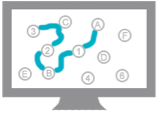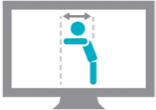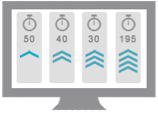Therapies
BITS provides therapy exercise and outcomes assessment for vision, cognition, motor, and balance abilities.
BITS therapies cover a wide range of exercises for patients with deficits resulting from traumatic injuries and movement disorders as well as competitive athletes. Each therapy category serves a unique function and clinical focus.
Assessments

Trail Making Assessment challenges working memory, visual attention, and task switching

Bell Cancellation task allows for a quantitative and qualitative assessment of visual neglect

Berg Balance Scale assesses static balance ability, fall risk and the executive functions of planning and foresight for patients with objective scoring measure.

Functional Reach Tests limits of stability by measuring the maximum distance a patient can reach.

Romberg Test assesses the effect on static balance with varying visual and propioceptive input.

Sensory Integration Test (SIT) assesses postural stability in stance with varying visual, proprioceptive & vestibular inputs.

Maze Test assesses attention, visuoconstructional ability and the executive functions of planning and foresight.

Visual Scan & Motor Reaction assesses visuomotor coordination, peripheral awareness, hand speed, reaction time and endurance.

Static Postural Sway assesses patient’s postural sway while maintaining balance in a fixed position.

Dynamic Postural Sway assess weight shifting, range of motion and postural control with guided exercise.
BITS 3.0 Therapy Categories

Visual Scanning

Visual Pursuit*

Cognitive

Visual Motor

Charts

Static Balance

Dynamic Balance

Optokentic Static and Optokentic Dynamic*

Vestibular
Contact us to see how BITS can work for every patient throughout their rehabilitation.
¹ Davis, J., Donaldson, M., Ashe, M., & Khan, K. (2004). The role of balance and agility training in fall reduction: A comprehensive review [Abstract]. Eura Medicophys, 40(3), 211-221. Retrieved August 20, 2020.
Indications for Use: The Bioness Integrated Therapy System (BITS) is intended to challenge and assess the visual, auditory, cognitive, motor, and balance abilities of individuals, including those with deficits resulting from traumatic injuries and movement disorders as well as competitive athletes (e.g. abilities include Visuomotor Coordination, Reaction Time, Visuospatial Perception, Visual & Auditory Processing, Working Memory, Physical & Cognitive Endurance, Balance Control, Postural Stability).
The Bioness Integrated Therapy System software programs utilize moving and rotating graphics that may cause dizziness, vertigo, or nausea in sensitive patients –use should be discontinued if experienced.
Full prescribing information can be found in product labeling or at: www.bionessrehab.com/bits/safety-information/.
Instructions for Use / Patient Guides and Reference Cards can be made available upon request.
Contact [email protected] or 800-211-9136 to request an electronic copy.

